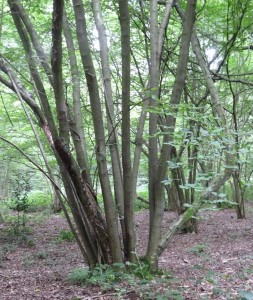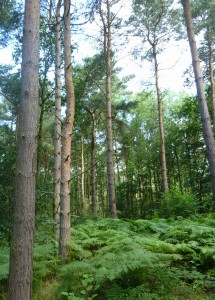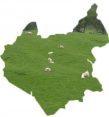
Early Leicestershire woodland
Leicestershire in 1086 was one of the least wooded counties in England. Converting from the length and breadth of woodland quoted in Domesday Book to hectares or acres is not an exact science, as few woods may have been rectangular, but other than ‘Hereswode’ which contained approximately 1,630 hectares (4,030 acres), only two manors, Groby and Thurcaston, may have had more than 400 hectares (1,000 acres) of wood. Most of the woodland was concentrated in two broad sweeps of countryside to the west and the south-east of the county, but what is most striking when the distribution of woodland is plotted, is the number of places in Leicestershire that had no woodland at all. That may have been the case since the 5th or 6th centuries: place-names containing the elements bearu (wood), graf (small wood), leah (clearing in woodland), lundr (wood) sceaga (small wood), wald (high woodland) and wudu (wood) are also relatively uncommon and concentrated in these two areas.
Some parish boundaries and ancient tracks suggest that wood-pasture was only available at some distance from a settlement. There are several parallel tracks to the north of Leicester which appear to link meadow land along the Soar valley to higher grazing in the east Leicestershire wolds, a few parishes have detached portions and to the south of the present city the boundaries of parishes including Narborough and Enderby were drawn to include long tongues which extended into what was once Leicester Forest.
Rights to take wood and to hunt
Estover was the right of a tenant to take wood, perhaps from some miles away, to repair his house or plough, and for fences and firewood. Wood was a valuable commodity and conflict often arose, for example from false claims that a tenancy gave that right, or when people took more than their entitlement in order to sell the wood at a profit. Lords might also try to rescind an earlier agreement to preserve the wood for their own use. In 1287 John le Fauconer claimed that for 6 years he had been prevented from taking his estovers ‘for burning, enclosing and building’ from John Comyn’s wood in Shepshed, a right which Fauconer claimed was attached to his tenancy in Thurcaston, over 10 miles away.
A case heard before the royal courts in 1240 concerned estover within a wood named ‘del Chalenge’ in the centre of Charnwood, but also set out the hunting rights within this land. In an agreement which almost foreshadows today’s Hunting Act, permission was given for the foresters of the earl of Arundel ‘to carry bows everywhere in the said woods, and arrows genderez and darts and shafts without the arrow being barbed’, and for the earl to hunt there, so long as his party took into the wood no more than ‘nine bows … and six hounds only for taking wounded deer, and without a pack of dogs and harriers’.
Principles of woodland management

Most native trees will regenerate if cut down to ground level (coppicing), producing a crop of wood suitable for many purposes, and this practice has formed the basis of woodland management for centuries. As the construction of houses (and ships) required large timbers, in most woods a small number of trees would be left to grow naturally, perhaps for a century or more, before being cut down. Today, we also recognise that our woods and forests have a key role to play in mitigating climate change, in providing the natural environment for native plants and animals to flourish and for leisure.
Timber trees
The tall trees left to grow between the coppices were known as timber trees. Those in the royal forests provided much of the wood used in the royal navy’s ships. Timber in other woods might also be sold to the navy, or could be used locally to construct the box or cruck frames used in house building. Offcuts might be used for furniture, both for the household and to provide screens and benches for churches.

Coppicing and pollarding
The cycle for coppicing could be as long as 21 years, the minimum period one writer suggested was necessary to prevent the local rector taking his tithe from the harvested wood. This would produce pieces large enough to make a sturdy fence, wheels for carts or bells and some furniture. Trees that were regularly coppiced would produce large stools which could grow to a diameter of several feet, and these can be seen in many ancient woods today. In parks and wood-pasture that was continually grazed by animals, pollarding was an alternative to coppicing, but was much harder physical work. The trees were cut back regularly some 6-10 feet (2-3 metres) above the ground, at a height that would prevent animals from eating the young shoots. Old pollard oaks can be recognised today by their sturdy trunk, topped by branches springing from a single level.

Plantations
We now build our ships from welded steel plates and our houses from bricks, but we still need timber, for electricity and telegraph poles, some furniture and for industry. Plantations of conifers best meet this need as they grow fast and straight, and can be planted at high densities. They usually die when felled, and have to be replaced by new saplings. Plantations can be large, for example Martinshaw Wood in Ratby is today largely a managed plantation of conifers, or can be small and intended to serve also as cover for foxes in hunting country.

